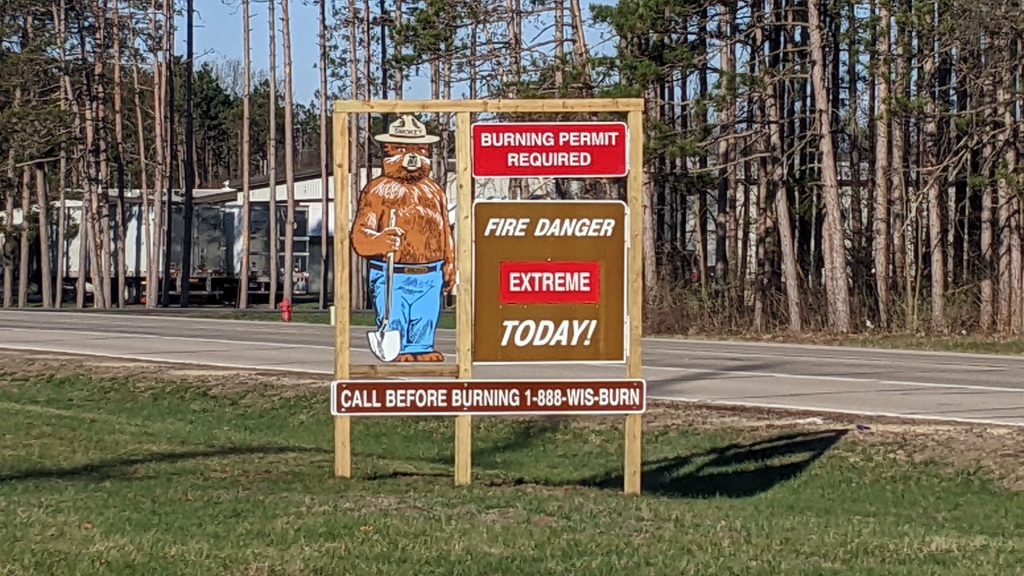
Source: Jimmie Kaska
DNR: Forest fire near Fort McCoy has burned over 2,800 acres
FORT MCCOY, Wis. (Civic Media) – The Wisconsin Department of Natural Resources says a forest fire has burned over 2,800 acres near Fort McCoy Wednesday into Thursday.
Mike Hillstrom, Public Information Officer with the DNR Incident Management Team, said the fire near Fort McCoy is 48% contained.
“We’ll see what happens as the temperature rises, the winds pick up this afternoon, hopefully those lines will hold and we’re getting all the resources we can to keep that one under control,” Hillstrom said.
The fire has prompted evacuation orders and closed highways in Jackson and Monroe counties. Highway 12 remained closed as of Thursday morning, while Interstate 94 re-opened late Wednesday night. Hillstrom said that highway closures may be needed on Thursday if smoke from the fire makes it difficult to see.
Hillstrom said that the fire along Fort McCoy’s northeast border and another fire Wednesday near the Necedah Airport in Juneau County are being referred to as the Black River Complex. The cause of each fire has not been identified.
“It’s being actively looked at by law enforcement,” Hillstrom said. “We’ll release that information as soon as we have an official cause of those fires.”
The DNR confirmed that some areas near the fire at Fort McCoy were given voluntary evacuation orders, with a shelter set up at the Warrens Community Center, but no one was at the shelter as of Thursday morning. The fire was burning through mostly pine and oak forest near Fort McCoy. The fire started late afternoon on Wednesday, Hiillstrom said. In a release, the DNR said that three structures had been damaged and one shed had been destroyed.
The fire near Necedah is controlled, Hillstrom said, and burned about 83 acres.
“I have not heard of any injuries,” Hillstrom said. “There have been some structures affected in both fires; from what I’ve heard so far, it’s more outbuildings.”
In a statement Wednesday, Fort McCoy said that they were working with fire departments to put out the fire, and that preventing the loss of life and property damage were the main priorities. Fort McCoy said that residents in the area should follow guidance from officials for evacuation orders. Earlier Wednesday, Fort McCoy said it was conducting two prescribed burns.
Gov. Tony Evers issued an executive order Wednesday declaring a state of emergency due to the critical risk of wildfires. The measure allows support for the DNR from the Wisconsin National Guard in the event of wildfire outbreaks. The National Weather Service issued a red flag warning Wednesday and Thursday for about two-thirds of Wisconsin, including Jackson, Juneau and Monroe counties, with a fire weather watch in effect for several other counties, due to unseasonably warm temperatures, gusty winds, and low humidity. In addition, the DNR placed most of the same counties under extreme risk of wildfires, its highest designation for wildfire risk.

According to the NWS, the warm air, bringing temperatures well into the 80’s and even into the 90’s across the state, as well as low humidity values of 20 to 25% and winds gusting to 35 mph, are all factors in the fire risk. Any fires that are started outdoors will spread quickly. The DNR said that there were 21 wildfires on Wednesday alone across Wisconsin, including the fires near Fort McCoy and the Necedah Airport, burning an estimated 2,500 acres.
The DNR is not issuing any burning permits in lands it controls and urges against any outdoor fires, including campfires, while the risk of wildfires is critically high.

According to the DNR, springtime is the most critical fire season in Wisconsin. That’s because leftover plant debris from the fall is dried out, while vegetation has not yet had a chance to flourish, creating hazardous conditions that could allow wildfires to spread quickly. Warmer temperatures in the spring, combined with low humidity and wind can fuel fires. Human activities, such as burning yard waste and clearing property, contribute to the majority of wildfires in the spring. Spring wildfires, from March through May, comprise the majority of all annual wildfires in Wisconsin over the past decade, according to the DNR.
The DNR provides a number of resources to help families, property owners, and communities plan for wildfires, including action plans if a wildfire is near a populated area.
FIRE SAFETY TIPS
- Avoid outdoor burning until conditions improve. Burn permits for debris burning are currently suspended in numerous counties.
- Operate equipment (chainsaws, off-road vehicles, lawnmowers, etc.) early in the morning or late in the day to avoid sparks at peak burn hours.
- Secure dragging trailer chains.
- Report fires early, dial 911.

Jimmie is Civic Media’s Sports Director who also works in digital content, sports, news, and talk programming. Email him at jimmie.kaska@civicmedia.us.
Want More Local News?
Civic Media
Civic Media Inc.
The Civic Media App
Put us in your pocket.
